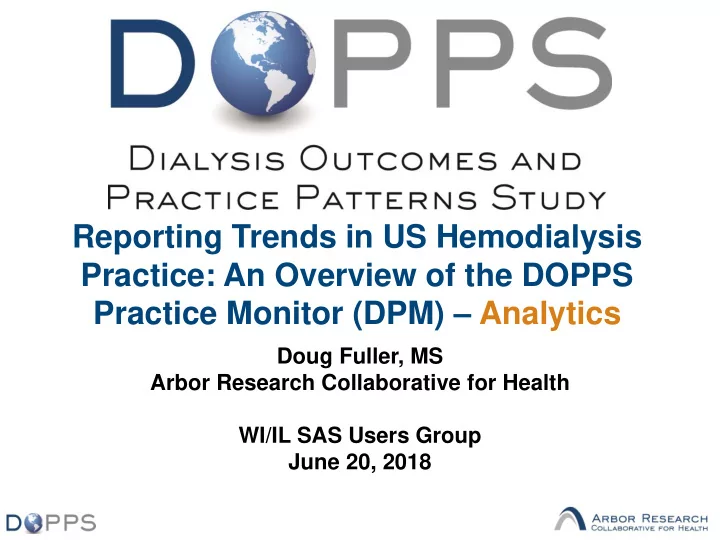

Reporting Trends in US Hemodialysis Practice: An Overview of the DOPPS Practice Monitor (DPM) – Analytics Doug Fuller, MS Arbor Research Collaborative for Health WI/IL SAS Users Group June 20, 2018
US DPM: Monthly data, updates every 4 months; >1500 figures & tables Stratified random sample (since 2010) Now ~200 US facilities, 14,000+ patients with data from 2 LDOs and Visonex www.dopps.org/DPM
DOPPS/DPM Sampling Protocol • Goal: Nationally representative estimates from samples of dialysis facilities and patients from each country • Approach: 2-stage, stratified random sampling design – Facilities randomly selected within 24 strata defined by geography and other variables – ~20-30 patients randomly selected/consented in each facility, replenished at four-month intervals – Facilities with <20 in-center hemodialysis patients excluded for operational efficiency (~5% of patients) • Intentional over-selection within certain strata, and unequal selection rates among facilities – Requires complex sample survey methods to obtain correct estimates
Dataset for BOXPLOTPARM Template: 1
Dataset for BOXPLOTPARM Template: 2
Template Definition: BOXPLOTPARM
Final Result: BOXPLOTPARM Template
Dataset for BARCHART Template: 1
Dataset for BARCHART Template: 2
Template Definition: BARCHART
Final Result: BARCHART Template
Summary • The DPM uses complex sample survey design and analytic methods to obtain nationally representative estimates of US dialysis practice measures. – Formal comparison to USRDS registry forthcoming! • The DPM extensively uses SAS macros and templates to generate flexible code and create a variety of customizable graphics options. • Rapid analysis using the DPM platform has identified and quantified several key changes to dialysis practice associated with contemporary changes to clinical guidelines and public policy before they could be assessed using national registry databases.
Recommend
More recommend